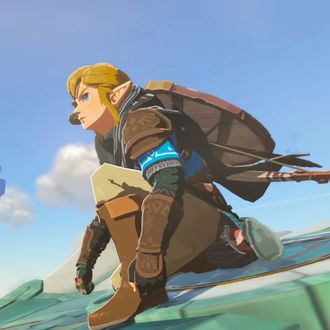
Gamers everywhere are smashing X for joy: Following the overwhelming critical success of 2017’s The Legend of Zelda: Breath of the Wild, sequel Tears of the Kingdom has kept up the good work. Released today, May 12, it’s accompanied with near universal raves. The game expands on BotW’s open-world concept with players able to explore Hyrule to their heart’s desire. There is additional vertical exploration, including floating islands above the land, and new gameplay abilities. Created by much of the same team that tackled BotW, including director Hidemaro Fujibayashi, the plot is typical for Zelda (save the kingdom from a mysterious evil force!), but what matters in Zelda is the how. Below, find the reviews that are cranking the anticipation for TotK up to an 11.
“Director Hidemaro Fujibayashi, producer Eiji Aonuma, and their team have crafted a layered world in which self-driven experimentation is paramount in traversal, combat, and discovery. If we interacted with Breath of the Wild on a micro level (scaling cliff sides, setting fire to the brush outside an enemy camp, collecting arrows that were embedded in our shield, to name a few examples), Tears of the Kingdom goes even deeper; after nearly 70 hours, I feel as if I can control its very molecules.” — Mike Mahardy, Polygon
“Link’s new powers are leagues better — and more interesting — than his old ones. They inspired in me a kind of ‘F- - - it, we ball’ attitude that set my brain on fire trying to figure out how to get to interesting places on the map or solve a difficult shrine or dungeon puzzle. Hyrule is littered with caches of wooden planks, beams, and wheels and a variety of neon-green machines called Zonai devices to pair with them. The devices range from the practical, like a portable pot to cook on the road, to the martial, like a fire emitter to stick on the end of a sword, to the esoteric, like the stabilizer that I have only used exactly once to great effect.” — Ash Parrish, the Verge
“If the primary emotion Breath instilled was the awe of exploring a new land, here it is the nostalgia of revising an old one. It feels like returning after many years of travel to find that a relative has renovated your beloved home (and added two extra wings to your house). You can quite literally navigate using the old map of BotW, but time and the cataclysm have reshaped Hyrule. Kakariko Village has been bombarded by ruins; a corporate mining company has taken over Death Mountain. Mazes have lifted up into the sky; a network of new caves pockmark the land.” — Will Bedingfield, Wired
“Exploration is the lifeblood of the recent Zeldas, though, and doing so is still an absolute delight in Tears — especially when the new building system empowers you to slap together custom cars, boats, and flying machines that truly let you navigate its world however you want. BotW has influenced countless other games since its release in 2017, but one of the most important lessons that very few of them seemed to learn is that a blank map can be more powerful than a full one. There is an enormous amount of stuff to do and see, and if you were handed a checklist of waypoints to methodically clear off right away it could easily feel overwhelming rather than exciting. Instead, you are given the bare minimum you need to complete the main quest, a pile of pins, and a blank map just begging you to fill it in yourself.” — Tom Marks, IGN
“Messing around with self-made contraptions led me to so many unexpected moments of glory, and also hilarity. Almost every time, Tears of the Kingdom answers the question ‘What happens if I do this?’ with ‘Something fun.’ Once, trapped in a blizzard in the snowy highlands, I improvised a rocket-powered sled and clung on for dear life as it careened down the hillside, totally out of control. Attaching a fan to my shield out of curiosity resulted in a hilarious run-in with some Bokoblins, in which I simply blew them backwards off the roof of their fort. I misaligned a rocket on a floating platform and accidentally sent myself flying sideways off it, rather than rising majestically into the air as planned.” — Keza MacDonald, the Guardian
“Tears of the Kingdom is sort of one enormous, invisible Assassin’s Creed tower, constructed not just of stone and metal but of play rhythms stemming from the distribution of objectives and raw materials. It’s an ephemeral and imposing structure that extends all the way from hell to heaven. Both its main quests and its various resourcing elements guide you steadily up and down this airy edifice: your eyes are constantly being drawn from one half of the game to the other.” — Edwin Evans-Thirwell, Eurogamer
“It’s like Nintendo watched all of those videos from Breath of the Wild of people combining the mechanics in ridiculous ways to fly straight to the last boss and made a game with that as the central ethos. As soon as you’re given extra tools like batteries, engines, balloons, and other equipment in The Legend of Zelda: Nuts & Bolts’ toolbox, it’s hard to stop your mind from racing.” — Jordan Middler, Video Game Chronicle
“The Legend of Zelda: Tears of the Kingdom was worth the six year wait. I knew it by the second hour — a slow, steady relief washed over me; the realization that the nail-biting saga of gaming’s most awaited sequel in years was going to have a happy ending for all us players after all. It was a relief soon followed by the simple, giddy thrill of knowing I had a really big, really good game to enjoy in the weeks to follow.” — Joel Franey, Games Radar
“These tools, and the sprawling world they inhabit, give Tears of the Kingdom a particular flow that feels unique to the Zelda franchise. You aren’t simply solving puzzles or fighting battles — you’re engineering solutions. You might encounter a gap you can’t cross, a fight you can’t win, or a puzzle you can’t solve. But you know you have the tools, and you know where you can find the materials, and all that’s left is to think it through, gather what you need, and put your plan into action. If that plan fails — and sometimes it will — you tweak your design or your plan and you try again. Despite the incredible freedom, it’s not overwhelming. While creative solutions are encouraged and might make some challenges much easier, you can certainly make it through the story using simpler designs. It rewards you for flexing your creative muscles, but it meets you where you are.” — Steve Watts, GameSpot


